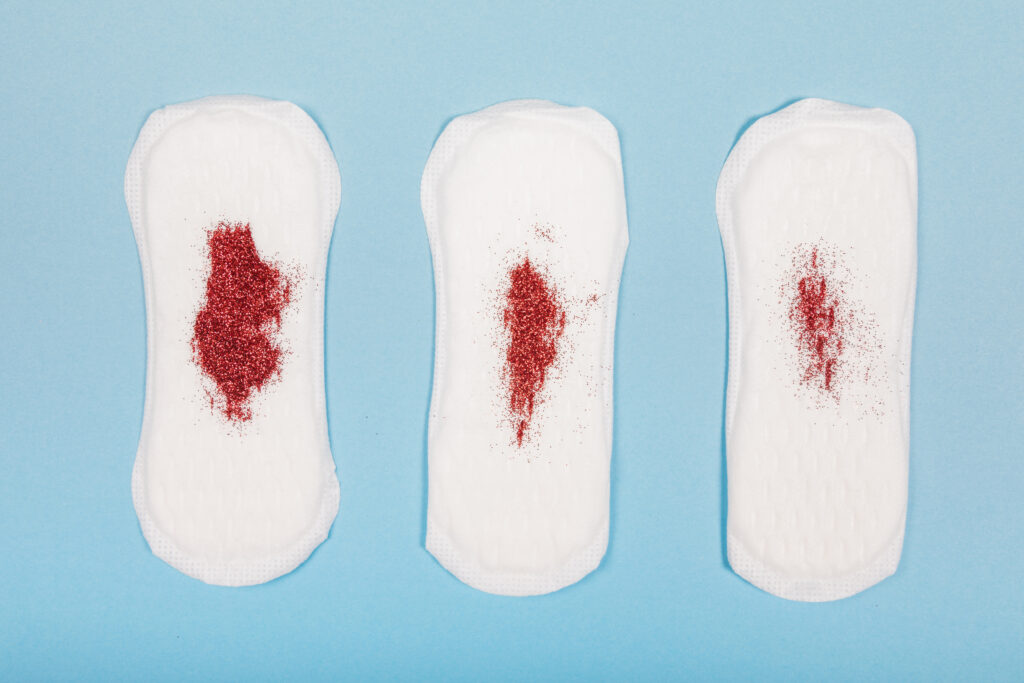In mature women, at puberty, ovaries start to release ova (eggs). Ovaries are the reproductive organs in the female body present in the pelvis. When the egg is fertilized by a sperm it passes to the fallopian tube and causes pregnancy. The fertilized eggs get attached to the inner walls of the uterus which develops into the placenta afterwards. A fertilized egg gets food and oxygen from the mother’s body through this placenta. But, if the egg remains unfertilized, the inner lining of the uterus known as endometrium is shed and the Menstrual Cycle gets started.
Menstruation has a complete cycle that starts on the first day of one period and ends on the first day of the next period. On average, the menstrual cycle lasts about 28 days, and a healthy female usually ovulates atonal 14 of this cycle. At the start of menstruation, most women have feelings of discomfort, including pain in the lower abdomen, bleeding, and spotting.
The ovulation procedure starts when you reach the age of puberty. This is when a mature egg or ovum is released from one of the ovaries. Female reproductive organs are called ad ovaries and these structures are located in your pelvic region. If the egg is fertilized by a sperm as it travels down the fallopian tube, then pregnancy occurs. The fertilized egg attaches to the lining of the uterus. The placenta then develops. The placenta is the structure that develops with the fertilization of the egg and provides nutrition and oxygen to the fetus. If the egg does not become fertilized, the lining of the uterus (endometrium) is shed during menstruation. Having sex a few days before and during ovulation enhances the chances of getting pregnant.
What is Menstruation?
When the lining of the inner walls of the uterus ruptures, menstruation gets started. This is the sign of the beginning of a period. A woman’s reproductive life depends on the menstrual cycle. During each menstrual cycle, the endometrium rebuilds itself and stores nutrients to nourish a future fetus. Reproductive hormones like estrogen and progesterone help it to get thinner and tougher. If sperm approaches the egg and fertilization of the ovum doesn’t occur, the inner lining of the uterus walls along with mucus from the vagina and blood from the cervix build up a menstrual flow that is released through the vagina throughout the menstruation or periods.
Thus menstruation is defined simply by the shedding of the uterus lining of the female. It is also known as the menstrual cycle, period, menses, or menstrual period. Blood released during menstruation contains tissues from inside of your uterus along with blood cells and flows out of your body through your vagina.
Studies prove that menstruation or the menstrual cycle is controlled by some reproductive hormones. These hormones work as messengers in your body and are produced by the ovaries and pituitary glands of your brain. The brain and ovaries release certain types of reproductive hormones during your menstrual cycle. These hormones help your uterus lining get thinner. The thinning of the endometrium ensures the safety of the egg if pregnancy occurs. The reproductive hormones also help in the release of eggs through the ovaries. From the uterus, the egg travels to the fallopian tube where it waits for fertilization through a sperm. If fertilization doesn’t occur, you cannot be pregnant. Then, the endometrium breaks down, and shedding starts. This is the start of a period of menstruation.
What is the Menstrual Cycle?
The menstrual cycle is the sequence of events that occur in the female body as it starts preparation for the possibility of getting pregnant each month. This cycle starts from the first day of your one menses and completes on the first day of the next menstrual period. The process of menstrual cycle is the same for every female but there may be slight differences according to health and circumstances.
When Does the Menstrual Cycle Start?
A woman naturally gets her menstrual cycle started at the age of 14 to 15 generally. Breast growth is the sign of preparation of the endometrium for the egg protection. Appearance of pubic and underarm hair is another sign of the start of menstruation on the average. At the initiation of the menstruation period, every girl experiences stress and discomfort. Some factors such as diet and strenuous exercise also affect the start of the menstrual cycle.
Research concluded that it is a matter of concern, if you do not get your menstrual cycle starting by the age of 16 or if you have not begun to develop underarm or pubic hair, or do not have grown breast buds. By the age of 14. Talk to your healthcare provider in such a situation.
Duration of Menstrual Cycle
On average, a menstrual cycle lasts for 28 to 29 days. It begins with the start of a period and ends with the first day of the next menstruation period. However, The duration of the menstrual cycle can slightly vary in some females. If a young girl has her first menstruation period, her menstrual cycle may be as short as 19 or 20 days or it may be as long as 40 to 45 days. But it will be a temporary condition and may last for a few initial years. Thus, the average menstrual cycle lasts between 21 to 40 days normal. However, if you feel anything out of this range, you need immediate medical attention.
How long Does a Period Last?
The average bleeding day for a menstruation period lasts from three to seven days. Studies suggested that period bleeding between three to seven days is normal. Having the shortest range of menstrual period i.e. for three days is OK.
Phases of Menstrual Cycle
Phases of your menstrual cycle are triggered by the rise and fall of your hormones. The reproductive hormones produce different types of responses in your reproductive tract. Here is a detailed description of specific events that usually occur during your menstrual cycle:

The Menses Phase: This phase starts with the first day of your period. It is the time when pregnancy doesn’t occur and the inner lining of your uterus sheds through your vagina. The bleeding continues for three to seven days normally but there is no need to worry if your period lasts for five or six days.The Follicular Phase: When your periods start and ovulation ends, the follicular phase gets started. It usually overlaps with the menses phase and ends when you ovulate. At this stage, the level of reproductive hormones rises which helps your endometrium to get thicker and stronger. A specific reproductive hormone known as follicle-stimulating hormone helps the follicles to grow in your ovaries. During this phase, between days 10 to 15, one of these follicles gets developed enough to form a fully mature egg.
Ovulation phase: In a 28-day menstrual cycle, ovulation occurs on the 14th or 15th day. A specific hormone luteinizing hormone suddenly increases at this stage and causes the release of eggs from your ovary. This is called ovulation.
The Luteal Phase: This is the longest phase of the menstrual cycle and lasts from day 16 to day 28. Here your egg is released from your ovary and travels through your fallopian tube to the uterus. The specific hormone progesterone helps the lining of the uterus to prepare for nourishing the ovum. If your egg is fertilized here by sperm the fertilized egg gets attached to the wall of the uterus and develops placenta here. Thus you would become pregnant. But in the case of non fertilization, the level of reproductive hormones i.e. estrogen and progesterone get dropped and the thick lining of the endometrium starts shedding. This shredded lining along with blood gets released during your period.
Typical Age of Start of Menstruation
The typical range for starting menstruation is between 8 to 16. However, on average girls aged 12 to 14 get their first period. Most females get their menstruation cycle started with the growth of their breasts and pubic hair.
In addition, the average age of stopping the menstrual cycle is around 50 years or more. This is called menopause. Menopause is the stoppage of egg production. If you have no periods for a year, you will have reached your menopause age.
Symptoms of Starting of Menstruation
Generally, studies do not show specific symptoms for starting menstruation in a mature woman. However, some people experience menstruation symptoms such as cramping. The cramps in your pelvic area are due to the contraction of the uterus walls for the release of its deteriorated lining. Symptoms of menstruation also vary from person to person. The common signs for getting your menstrual period include:
- Bloating.
- Headache.
- Mood Changes.
- Food Cravings.
- Trouble sleeping.
- Acne.
- Breast tenderness.
Changes in your Menstruation Period Over Time
Menstruation period intensity, duration, and symptoms change from your teenage to your 50s. At the start of menstruation, you get a heavier period flow with a longer menstrual cycle. Approximately, it takes three years to have regular menstruation after the beginning of the menstrual cycle. The properties of a normal menstrual cycle are:
- It causes heavy flow bleeding for the first three days that gets slow and in low volume up to day 7.
- It occurs roughly every 20 to 30 days.
- Reaching the age of twenty, means after your teenage, your period becomes more regular and consistent. But after getting in your 40s, your period once again becomes irregular and this is the sign of initiating the menopause.
- Certain life events also cause sudden irregularities in your period such as childbirth or lactation period after pregnancy.
Symptoms of Irregular Menstruation
Abnormal menstruation periods are considered irregular menstrual cycles. Here are some examples of irregularity in the menstruation period:
- Menstrual cycle that lasts for less than 20 days or more than 40 days.
- Period bleeding that continues after seven days and causes severe back or abdomen pains.
- Having three or more than three months without periods.
- Much heavier or lighter bleeding flow than usual.
- Spotting or bleeding that occurs during this period.
- Periods accompanied by vomiting, nausea, severe cramping, or lower abdominal pains.

What is the Normal Bleeding during Your Period? Generally, you would lose just four to five tablespoons of blood during your period. However, some variation may occur due to uncertain causes. Common Signs of the irregular period are:
- Bleeding for more than seven days.
- Leakage of your menstruation pad every two hours.
- Release of blood clots larger than a quarter with bleeding.
However, experiencing some variations in the amount of bleeding each cycle;e is a normal thing. Also, remember that your normal variations may be not normal for others. Don’t compare your experience to someone else’s. If you are eager to know what’s normal for you, talk to your healthcare provider. They may help to diagnose the causes of severe or irregular bleeding during your menstruation.
How Can You Track Your Menstrual Cycle?
Try to be aware of your menstrual cycle. If you’re not having a period, don’t worry because it does not seem like a big deal. However, irregular menstruation periods can be an indication of serious problems. Tell your healthcare provider about your most recent period and the duration of your menstrual cycle. They may help you to know what’s normal for you.
Tracking your menstruation period can help you to evaluate the chances of getting pregnant. That means you can know about your ovulation stage. Thus you can easily plan ahead or get preparations for your pregnancy or period bleeding during your vacation or a special event.
You can follow the trips jotted below to easily track your menstrual cycle:
- Mark your first day of menstruation period with a highlighter on a calendar.
- Keep on marking each day of bleeding during your period.
- Stop marking at the end of the menstruation period.
- Once again mark on the calendar when you get the next period. This will be day one of the next period.
- Now, count the number of days between the previous day 1 and the present day 1 of your period. This is the actual duration of your menstrual cycle.
- Now count the highlighted days to know about the number of days you bleed during your period.
Conclusion
Your menstrual cycle depicts a clear picture of your reproductive health. You can get valuable insight by tracking your menstruation period. A normal menstrual cycle lasts from 200 to 30 days while variations from this rage can be a matter of concern in some cafes. Bleeding between three to seven days during a period is also a sign of a normal period. But in case of fewer or more bleeding days than the average, contact your healthcare professional. Discuss your concerns about your menstrual cycle because an irregular menstrual cycle sometimes is an indication of a certain health condition that needs immediate medical attention.
You need to contact your doctor if you don’t start your menstrual cycle by the age of 16, sudden bleeding for more than average days, bleeding much heavier or lighter than usual, or experiencing severe pain or sickness during or after a period.







